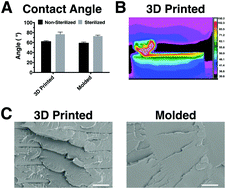The influence of roughness on stem cell differentiation using 3D printed polylactic acid scaffolds
Abstract
With the increase in popularity of 3D printing, an important question arises as to the equivalence between devices manufactured by standard methods vs. those presenting with identical bulk specifications, but manufactured via fused deposition modeling (FDM) printing. Using thermal imaging in conjunction with electron and atomic force microscopy, we demonstrate that large thermal gradients, whose distribution is difficult to predict, are associated with FDM printing and result in incomplete fusion and sharkskin of the printing filament. Even though these features are micro or submicron scale, and hence may not interfere with the intended function of the device, they can have a profound influence if the device comes in contact with living tissue. Dental pulp stem cells were cultured on substrates of identical dimensions, which were either printed or molded from the same PLA stock material. The cultures exhibited significant differences in plating efficiency, migration trajectory, and morphology at early times stemming from attempts by the cells to minimize cytoplasm deformation as they attempt to adhere on the printed surfaces. Even though biomineralization without dexamethasone induction was observed in all cultures at later times, different gene expression patterns were observed on the two surfaces. (Osteogenic markers were upregulated on molded substrates, while odontogenic markers were upregulated on the FDM printed surfaces.) Our results clearly indicate that the method of manufacturing is an important consideration in comparing devices, which come in contact with living tissues.



 Please wait while we load your content...
Please wait while we load your content...